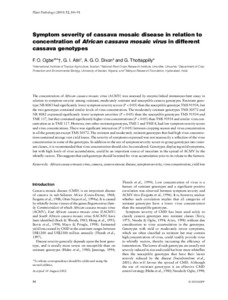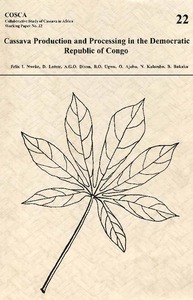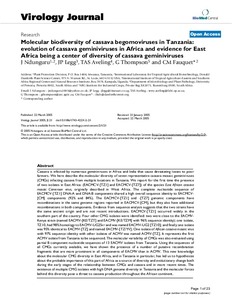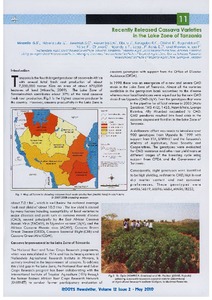| dc.contributor.author | Ogbe, F. |
| dc.contributor.author | Atiri, G. |
| dc.contributor.author | Dixon, Alfred G.O. |
| dc.contributor.author | Thottappilly, G. |
| dc.date.accessioned | 2019-12-04T11:23:43Z |
| dc.date.available | 2019-12-04T11:23:43Z |
| dc.date.issued | 2003-02 |
| dc.identifier.citation | Ogbe, F.O., Atiri, G.I., Dixon, A.G.O. & Thottappilly, G. (2003). Symptom severity of cassava mosaic disease in relation to concentration of African cassava mosaic virus in different cassava genotypes. Plant Pathology, 52(1), 84-91. |
| dc.identifier.issn | 0032-0862 |
| dc.identifier.uri | https://hdl.handle.net/20.500.12478/4125 |
| dc.description.abstract | The concentration of African cassava mosaic virus (ACMV) was assessed by enzyme-linked immunosorbent assay in relation to symptom severity among resistant, moderately resistant and susceptible cassava genotypes. Resistant genotype NR 8083 had significantly lower symptom severity scores (P < 0·05) than the susceptible genotype TMS 91934, but the two genotypes contained similar levels of virus concentration. The moderately resistant genotypes TMS 30572 and NR 8082 expressed significantly lower symptom severities (P < 0·05) than the susceptible genotypes TMS 91934 and TME 117, but they contained significantly higher virus concentrations (P < 0·05) than TMS 91934 and similar virus concentration as in TME 117. However, two other resistant genotypes, TME 1 and TME 8, had low symptom severity scores and virus concentrations. There was significant interaction (P ≤ 0·05) between cropping season and virus concentration in all the genotypes except TMS 30572. The resistant and moderately resistant genotypes that had high virus concentrations sustained storage root yield losses. The severity of symptoms expressed was not necessarily a reflection of the virus concentration in some of the genotypes. In addition to the use of symptom severity scores to group genotypes into resistant classes, it is recommended that virus concentration should also be considered. Genotypes displaying mild symptoms, but with high levels of virus accumulation, could be an important source of inoculum in the spread of ACMV by the whitefly vectors. This suggests that each genotype should be tested for virus accumulation prior to its release to the farmers. |
| dc.language.iso | en |
| dc.subject | African Cassava Mosaic Virus |
| dc.subject | Cassava |
| dc.subject | Plant Diseases |
| dc.subject | Viruses |
| dc.subject | Yield Loss |
| dc.subject | Genotypes |
| dc.title | Symtom severity of cassava mosaic disease in relation to concentration of African cassava mosaic virus in different cassava genotypes |
| dc.type | Journal Article |
| dc.type | Journal Article |
| dc.description.version | Peer Review |
| cg.contributor.crp | Roots, Tubers and Bananas |
| cg.contributor.affiliation | International Institute of Tropical Agriculture |
| cg.contributor.affiliation | University of Ibadan |
| cg.coverage.region | Africa |
| cg.coverage.region | West Africa |
| cg.coverage.country | Nigeria |
| cg.isijournal | ISI Journal |
| cg.authorship.types | CGIAR and developing country institute |
| cg.iitasubject | Cassava |
| cg.iitasubject | Plant Diseases |
| cg.iitasubject | Plant Breeding |
| cg.accessibilitystatus | Limited Access |
| local.dspaceid | 99691 |
| cg.identifier.doi | https://doi.org/10.1046/j.1365-3059.2003.00805.x |




